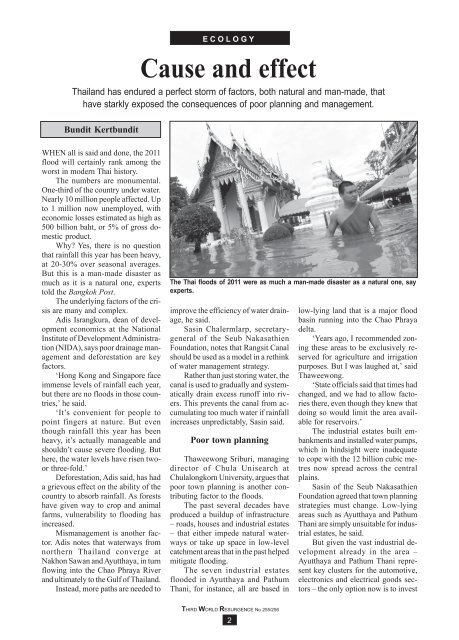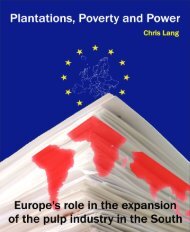Download - Third World Network
Download - Third World Network
Download - Third World Network
You also want an ePaper? Increase the reach of your titles
YUMPU automatically turns print PDFs into web optimized ePapers that Google loves.
Cause and effectThailand has endured a perfect storm of factors, both natural and man-made, thathave starkly exposed the consequences of poor planning and management.Bundit KertbunditE C O L O G YWHEN all is said and done, the 2011flood will certainly rank among theworst in modern Thai history.The numbers are monumental.One-third of the country under water.Nearly 10 million people affected. Upto 1 million now unemployed, witheconomic losses estimated as high as500 billion baht, or 5% of gross domesticproduct.Why? Yes, there is no questionthat rainfall this year has been heavy,at 20-30% over seasonal averages.But this is a man-made disaster asmuch as it is a natural one, expertstold the Bangkok Post.The underlying factors of the crisisare many and complex.Adis Israngkura, dean of developmenteconomics at the NationalInstitute of Development Administration(NIDA), says poor drainage managementand deforestation are keyfactors.‘Hong Kong and Singapore faceimmense levels of rainfall each year,but there are no floods in those countries,’he said.‘It’s convenient for people topoint fingers at nature. But eventhough rainfall this year has beenheavy, it’s actually manageable andshouldn’t cause severe flooding. Buthere, the water levels have risen twoorthree-fold.’Deforestation, Adis said, has hada grievous effect on the ability of thecountry to absorb rainfall. As forestshave given way to crop and animalfarms, vulnerability to flooding hasincreased.Mismanagement is another factor.Adis notes that waterways fromnorthern Thailand converge atNakhon Sawan and Ayutthaya, in turnflowing into the Chao Phraya Riverand ultimately to the Gulf of Thailand.Instead, more paths are needed toThe Thai floods of 2011 were as much a man-made disaster as a natural one, sayexperts.improve the efficiency of water drainage,he said.Sasin Chalermlarp, secretarygeneralof the Seub NakasathienFoundation, notes that Rangsit Canalshould be used as a model in a rethinkof water management strategy.Rather than just storing water, thecanal is used to gradually and systematicallydrain excess runoff into rivers.This prevents the canal from accumulatingtoo much water if rainfallincreases unpredictably, Sasin said.Poor town planningThaweewong Sriburi, managingdirector of Chula Unisearch atChulalongkorn University, argues thatpoor town planning is another contributingfactor to the floods.The past several decades haveproduced a buildup of infrastructure– roads, houses and industrial estates– that either impede natural waterwaysor take up space in low-levelcatchment areas that in the past helpedmitigate flooding.The seven industrial estatesflooded in Ayutthaya and PathumThani, for instance, all are based inlow-lying land that is a major floodbasin running into the Chao Phrayadelta.‘Years ago, I recommended zoningthese areas to be exclusively reservedfor agriculture and irrigationpurposes. But I was laughed at,’ saidThaweewong.‘State officials said that times hadchanged, and we had to allow factoriesthere, even though they knew thatdoing so would limit the area availablefor reservoirs.’The industrial estates built embankmentsand installed water pumps,which in hindsight were inadequateto cope with the 12 billion cubic metresnow spread across the centralplains.Sasin of the Seub NakasathienFoundation agreed that town planningstrategies must change. Low-lyingareas such as Ayutthaya and PathumThani are simply unsuitable for industrialestates, he said.But given the vast industrial developmentalready in the area –Ayutthaya and Pathum Thani representkey clusters for the automotive,electronics and electrical goods sectors– the only option now is to investTHIRD WORLD RESURGENCE No 255/2562















